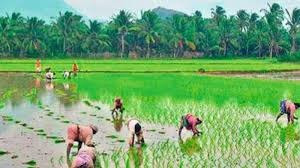ORGANIC FARMING
Organic farming is a production system which avoids the use of synthetically compound fertilizers, pesticides, growth regulators, and livestock feed additives.To the maximum extent feasible, organic agriculture systems depend upon crop rotations,crop residues, animal manure, green manure, off-farm organic wastes, mechanical cultivation, mineral bearing rocks, and aspects of biological pest control to maintain soil productivity to supply plant nutrients and to control insects, weeds, and other pests.
The concept of the soil as a living system which must be “fed” in a way that does not restrict the activities of beneficial organisms necessary for recycling nutrients and producing the organic component of soil, formed by the decomposition of leaves and other plant material by soil microorganisms.
Organic agriculture is a characterized by the belief that the parts of something are intimately interconnected and explicable only by reference to the whole production management system which promotes and enhances agro-ecosystem health, including bio-diversity, biological cycles and soil biological activity.
It emphasizes the use of management practices in preference to the use of off-farm inputs, taking into account that regional conditions require locally adapted systems. This is accomplished by using wherever possible, agronomic, biological, and mechanical methods, as opposed to using synthetic materials, to fulfill any specific function within the system.
Principles of organic farming:
- To produce food of high nutritional quality in sufficient quantity
- To interact in a constructive and life enhancing way with all natural systems and cycles
- To encourage and biological cycles with in the farming system, involving micro-organisms, soil flora and fauna, plants and animals and careful mechanical intervention
- To maintain and increase long-term fertility of soils
- To promote the healthy use and proper care of water
- To maintain the genetic diversity of the production system and its surroundings including the protection of wild life habitats
- To produce non-food products from renewable resources, which are fully degradable.
- To encourage organic agriculture associations to function along democratic lines and the principle of division of powers.
Components of organic farming:
Diverse crop rotations:
Crop diversification can deliver many agronomic and ecological benefits simultaneously, while maintaining the scale and efficiency of production.
Benefits of diverse crop rotations include yield stability, reduction in disease incidence & severity, reduced pest incidence, improved weed control, reduced soil erosion, recycling of nutrient reserves, nitrogen from nitrogen fixing species, structural improvement.
There are many different forms of crop diversification , rotational cropping, sequential cropping, inter cropping, multi storied cropping system and in practice these can be combined within the farming system.Crop and variety choice and their spatial and temporal design are critical in ensuring an effective rotation.
Soil fertility management:
The aim of nutrient or soil fertility management within organic farming systems is to work, as far as possible, with in a closed system .Organic farming aims to manage soil fertility through use of organic manures recycling of crop residues such as straw, plant residues, grasses .Dung and urine from domesticated animals and wastes from slaughter houses, human excreta & sewage, biomass of weeds, organic wastes from fruit and vegetable production & processing units and household wastes, sugarcane trash, oil cakes, press mud and fly ash from thermal power plant.
Integrated nutrient management:
Integrated nutrient management system envisages conjunctive use of organic manures, crop residues, bio fertilizers, legumes in crop rotation and green manuring. It combines traditional and improved technologies to gain from the symbiosis and synergy of crop- soil-environment bio-interactions. The concept is for optimization of all available sources of plant nutrients to improve soil fertility availing nature’s gifts.
Recycling of organic wastes:
Substantial quantities of crop residues (350 million tons) are produced in India every year.
Crop residues in combination with organics have been shown to improve availability of plant nutrients, soil organic matter, aggregate stability, infiltration rate, microbial population.
Bio-fertilizers:
Bio-fertilizers such as rhizobium culture is an effective source of N supply to leguminous corps.
Azotobacter and Azospirillium help in N fixation and supply to crops like rice, wheat, sorghum, maize, cotton, sugarcane, fruit corps and vegetables. Phosphate solubilising bacteria , Bacillus aspergillus help in making available soil P to the crops and increase the solubility of indigenous sources of P like rock phosphate.
Blue green algae and Azolla have shown promise in low land rice. These are renewable and environment friendly supplementary sources of nutrients and are presently being used in quantities between 8-10 tons per year. Vesicular arbuscular mycorrhiza (VAM) has beneficial effect on plant growth, particularly in P deficient soils.Improved uptake of water, production of plant hormones and microbial activity are the prime benefits of mycorrhizal inoculations.
Green manuring:
Green manuring is a cheap alternative to the use of fertilizer N.The process also makes a positive contribution to the maintenance of soil organic matter at a satisfactory level.There is also greater scope for green-leaf manuring for rice and other crops from the lopping of various multipurpose trees popularized through afforestation and agro-forestry systems.Popularization of bio-gas plants, encouraging legumes in crop rotation and inter cropping system and use of sewage, sludges and effluents for agriculture can also be the components of INMS.


Good
ReplyDelete